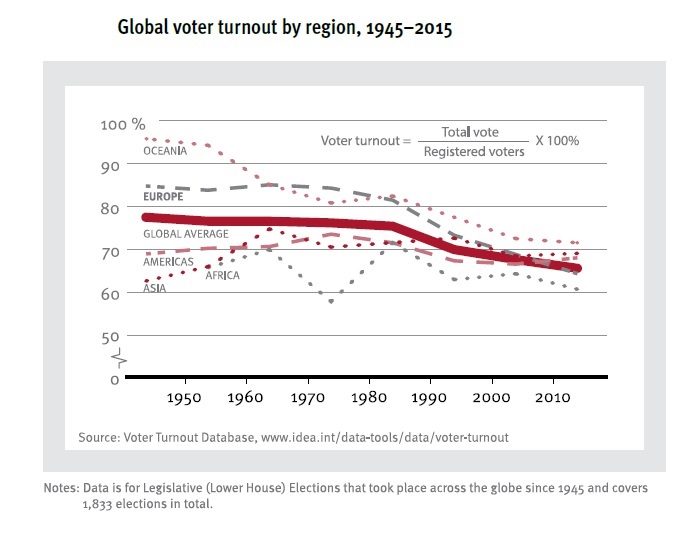Declining voter participation has become a global concern and a steady electoral pattern in the last thirty years.
According to The Voter Turnout database developed by the International Institute for Democracy and Electoral Assistance (IDEA), “global voter turnout was fairly stable between the 1940s and the 1980s. It then fell sharply in the 1990s, and continued its decline to reach 66 per cent in the period of 2011–15.” The database shows that currently, almost half the countries in the world have voter turnouts of 60–79 per cent, but the numbers are plummeting.
Some experts argue that declining voter turnout signals “the deep problems democracies are facing today,”[1] or as Pascal Delwit affirms in The End of Voters in Europe?, “The scientific community and politicians have been regularly alarmed by political and electoral participation, portrayed as undergoing a brutal and linear decline.”
However, the way turnout rates are measured can also offer multifarious perspectives. Voter turnout can be measured based on voting age population (VAP), voting-eligible population or registered voters. Given the United States case, “those who argue that a healthy democracy needs high voter turnout will look at the voting-age population or voting-eligible population.”[2] The Pew Research claims the 55.7% VAP turnout in 2016 puts the U.S. behind most of its peers in the OECD.

Voter participation can be affected by a multitude of factors. Among the most common arguments are voters’ residential mobility, voter apathy, complex and/or rigid voting arrangements, mistrust of the political process and perceived level of corruption, economic adversity (economic hardship can lead people to withdraw from politics and focus on meeting their basic needs), and voter fatigue (the less time there is between elections, the lower the turnout).
Interestingly, age is one of the most consistent factors affecting voter turnout. Most researchers argue youth voter apathy is becoming a global concern. The IDEA paper on voter turnout shows “those between 18 and 25 are least likely to vote, while those 65 to 74 are most likely.” Some reasons could be that they move frequently; they are less engaged in government and politics; or also because “for some young voters, government is a distant concept rather than a daily concern.”[3]
However, not everything seems lost when dealing with low voter turnout rates. Some solutions offered by elections experts include, in first place, contemplating compulsory voting. The aforementioned database shows that among the 26 countries with compulsory voting “12 (46%) are located at the top of the list, with turnout rates above 81%” Australia is often in the top-20 with the highest voter turnout. Voting, like taxes and jury duty, is mandatory for Australians. Belgium and Turkey also have similar voting laws, which help them attain VAP turnouts of 87% and 86%.
Other possible ways to improve voter participation are facilitating voter registration procedures (i.e. automatic registration of voters. Sweden and Germany automatically register their voters, and they have 83% and 66% voter turnout, respectively); making voting arrangements more flexible and accessible (including availability of election technology and multiple options for early voting); planning concurrent elections (when several elections take place on the same day, turnout is higher); analysing how to better engage young voters (including their concerns in political campaigns, connect with them via technology, etc.); and improving not only public participation in democracy but also guaranteeing satisfaction of human rights and socio-economic situation of voters.